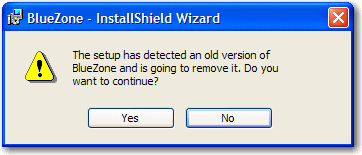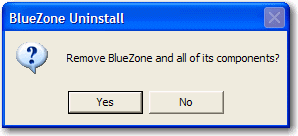|
Installing BlueZone |
Chapter 2 |
Upgrading BlueZone Version 3.2 or Earlier
Overview
This procedure is written specifically for upgrading
BlueZone versions 3.2 or earlier. It
is important to review the entire BlueZone
Upgrade Procedure before proceeding.
Starting with BlueZone version 4.1, BlueZone uses an
MSI type installer (InstallShield Wizard), to keep track of all the installed
BlueZone files. Since
you are upgrading a version of BlueZone 3.2 or earlier, this is the first
time that the InstallShield Wizard
has had an opportunity to run. This
means that for this upgrade only, you will be performing what is essentially
a BlueZone installation. In
the future, BlueZone upgrades will be under the control of the InstallShield
Wizard and therefore much easier to perform.
 IMPORTANT!
Please
be aware that starting with version 3.3, BlueZone defaults to Profile
Mode. Prior
to version 3.3, the default mode for BlueZone was Registry
Mode. In
Registry Mode, all your BlueZone session configurations were stored in
the Windows registry. In
Profile Mode, all your session configurations are stored in files called
Profiles. To
convert to Profile Mode, all you have to do is install BlueZone (using
the default settings) on top of your current installation. When
the installation is complete, launching the BlueZone Session Manager will
automatically convert all your Registry settings to Profiles.
IMPORTANT!
Please
be aware that starting with version 3.3, BlueZone defaults to Profile
Mode. Prior
to version 3.3, the default mode for BlueZone was Registry
Mode. In
Registry Mode, all your BlueZone session configurations were stored in
the Windows registry. In
Profile Mode, all your session configurations are stored in files called
Profiles. To
convert to Profile Mode, all you have to do is install BlueZone (using
the default settings) on top of your current installation. When
the installation is complete, launching the BlueZone Session Manager will
automatically convert all your Registry settings to Profiles.
We recommend that you do not use the Desktop Shortcuts
to launch BlueZone sessions. Instead,
use the BlueZone Session Manager to launch your sessions. However,
if you already have BlueZone desktop shortcuts on your desktop, they will
remain there after the upgrade is completed.
As mentioned above, the BlueZone Session Manager, will
automatically convert your BlueZone configuration Registry entries into
Profiles. The
following naming format will be used:
|
BlueZone Session |
Profile Name |
|
Mainframe Display, Session 1 |
Mainframe Display S1.zmd |
|
Mainframe Printer, Session 1 |
Mainframe Printer P1.zmp |
|
iSeries Display, Session 1 |
iSeries Display S1.zad |
|
iSeries Printer, Session 1 |
iSeries Printer P1.zap |
|
BlueZone VT Session 1 |
VT S1.zvt |
|
BlueZone FTP Session 1 |
FTP T1.zft |
If you have more than one session defined, the file name
will be named accordingly. For
example, Mainframe Display Session 2 will be named Mainframe Display S2.zmd.
Later, you will see that in Profile Mode, BlueZone places
the name of the Profile in the upper left hand corner of the emulator,
immediately to the right of the session number. If
you wish, you can change the name of the Profile to a name that is more
meaningful.
If you are ready to upgrade, continue with the following
BlueZone Upgrade Procedure.
When the installation is complete, launch the new BlueZone
Session Manager to convert your BlueZone configuration Registry entries
into Profiles. Your
BlueZone Registry entries will be automatically removed.
BlueZone Upgrade Procedure
Insert the BlueZone
CD-ROM into your computer's CD/DVD drive. The
Welcome to BlueZone "Splash
Screen" will appear.
Click on the BlueZone
Desktop link and select BlueZone
Desktop. You
will be presented with the main BlueZone
Installation Language screen.
Select the desired language
from the drop down list and press the OK
button. You
will be presented with the Welcome to
the InstallShield Wizard for BlueZone screen.
Click the Next
button. You
will be presented with the License Agreement
screen.
To proceed,
select the "I accept the terms in the license agreement" radio
button and click the Next button.
You will
be presented with the Destination Folder
screen.
Change the Installation
and Working Directories as needed or take the default (recommended)
and click the Next button. You
will be presented with the Component
Selection screen.
Review the default selections.
Use the
scroll bar on the right hand side view all components. By
default, some BlueZone components are selected for installation and some
are not. The
components that have a diskette icon  will be installed
and the components that have a red X icon
will be installed
and the components that have a red X icon  will not be installed.
With your
mouse pointer, left click the BlueZone components you wish to change.
Also, choose
whether you want BlueZone to be available to all users of just yourself.
will not be installed.
With your
mouse pointer, left click the BlueZone components you wish to change.
Also, choose
whether you want BlueZone to be available to all users of just yourself.
 NOTE For
a description of a particular component, highlight the component with
your mouse pointer and read the Feature
Description, which will appear on the right hand side of the screen.
NOTE For
a description of a particular component, highlight the component with
your mouse pointer and read the Feature
Description, which will appear on the right hand side of the screen.
Click the Next
button. The
Choose Activation File screen
will be displayed. Since
this is an upgrade, you should already have a
(SAF) stored on your hard drive in the location where your previous version
of BlueZone was installed. If
you have not changed the location where the BlueZone files will be installed,
you do not have to do anything.
If you have changed the BlueZone installation
location, then use the Browse
button to browse to the location where your SAF file installed.
Click the Next
button. The
Ready to Install the Program screen
will be displayed.
Click the Install
button. The
following message will be displayed:

Click the Yes
button. The
following message will be displayed:

Click the No
button. The
InstallShield Wizard will now install the required BlueZone files. When
the installation is complete, you will receive a message that the BlueZone
installation was completed successfully.
Click the
Finish button to exit the Wizard.
You will
receive a restart your system message. In
order to complete the upgrade process, you must restart your system.
Click the
Yes button.
After your
system has restarted, launch the BlueZone Session Manager by launching
it from the BlueZone Session Manager desktop shortcut. If
you do not have a shortcut, launch the BlueZone Session Manager from your
installed programs.
 CAUTION! This
step is very important. It's
the launching of the BlueZone Session Manager that converts your BlueZone
configurations that are stored in the Windows Registry to BlueZone profiles.
This step
completes the conversion of your BlueZone installation from Registry
Mode to Profile Mode.
CAUTION! This
step is very important. It's
the launching of the BlueZone Session Manager that converts your BlueZone
configurations that are stored in the Windows Registry to BlueZone profiles.
This step
completes the conversion of your BlueZone installation from Registry
Mode to Profile Mode.
Congratulations!
You have
just successfully upgraded your version of BlueZone.
Related Topics:
Modifying
BlueZone
SEAGULL
Registration Wizard
 IMPORTANT!
Please
be aware that starting with version 3.3, BlueZone defaults to Profile
Mode. Prior
to version 3.3, the default mode for BlueZone was Registry
Mode. In
Registry Mode, all your BlueZone session configurations were stored in
the Windows registry. In
Profile Mode, all your session configurations are stored in files called
Profiles. To
convert to Profile Mode, all you have to do is install BlueZone (using
the default settings) on top of your current installation. When
the installation is complete, launching the BlueZone Session Manager will
automatically convert all your Registry settings to Profiles.
IMPORTANT!
Please
be aware that starting with version 3.3, BlueZone defaults to Profile
Mode. Prior
to version 3.3, the default mode for BlueZone was Registry
Mode. In
Registry Mode, all your BlueZone session configurations were stored in
the Windows registry. In
Profile Mode, all your session configurations are stored in files called
Profiles. To
convert to Profile Mode, all you have to do is install BlueZone (using
the default settings) on top of your current installation. When
the installation is complete, launching the BlueZone Session Manager will
automatically convert all your Registry settings to Profiles. NOTE
NOTE